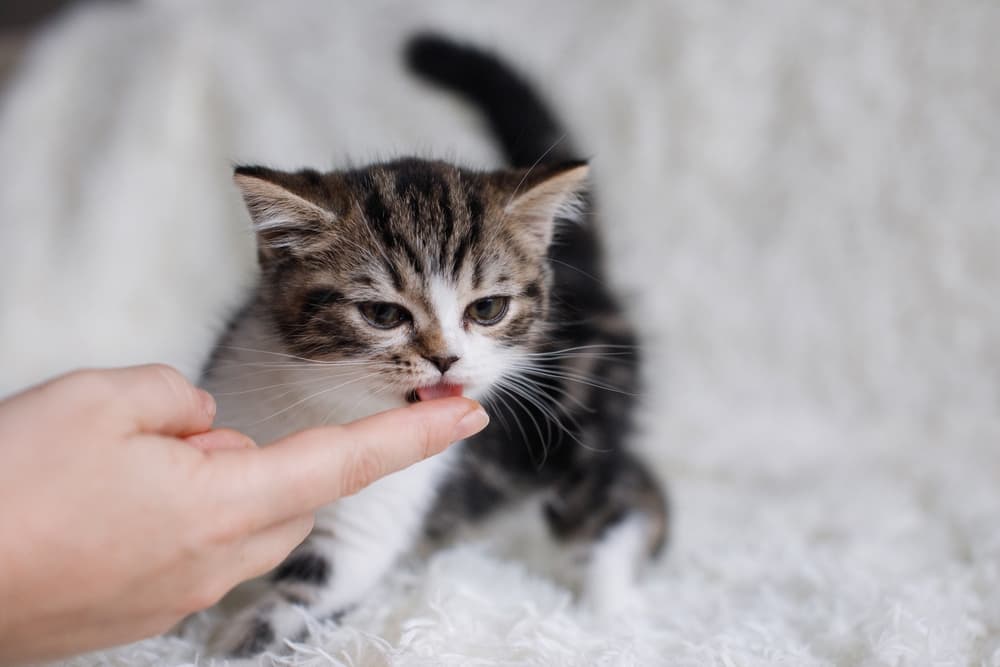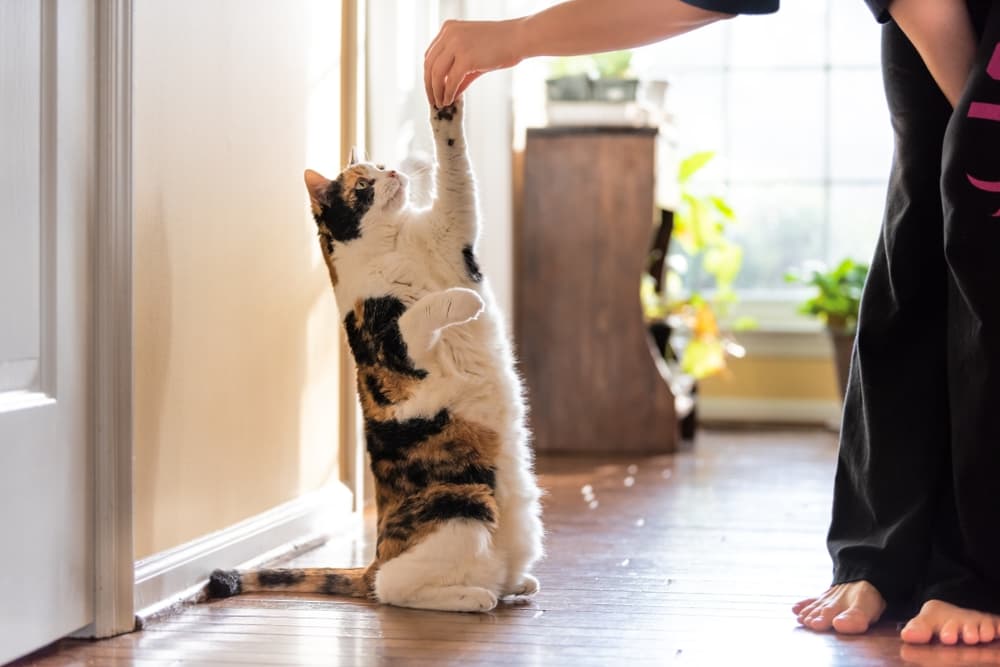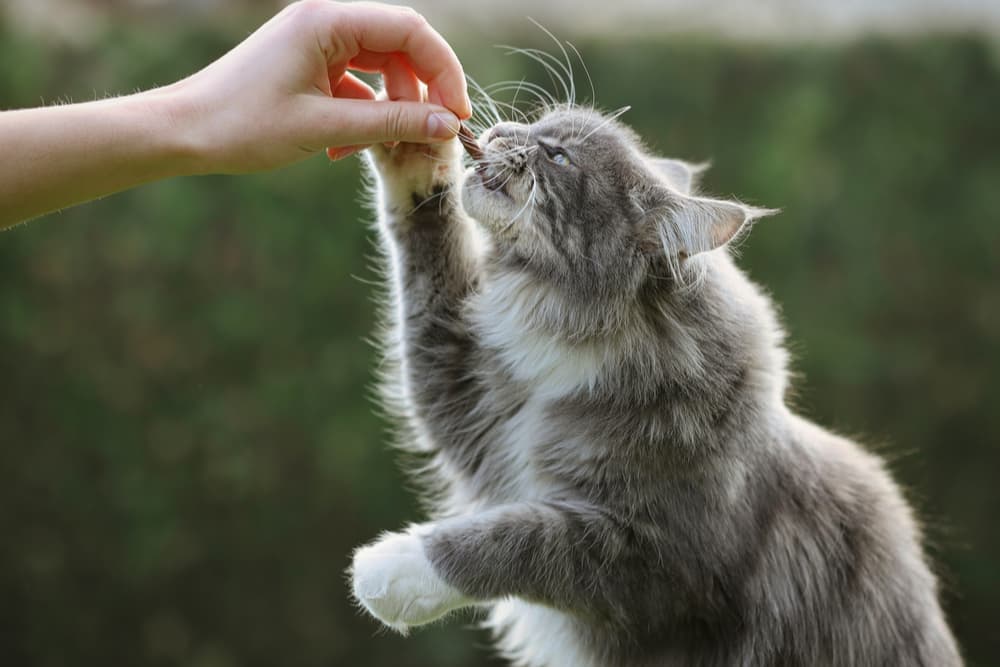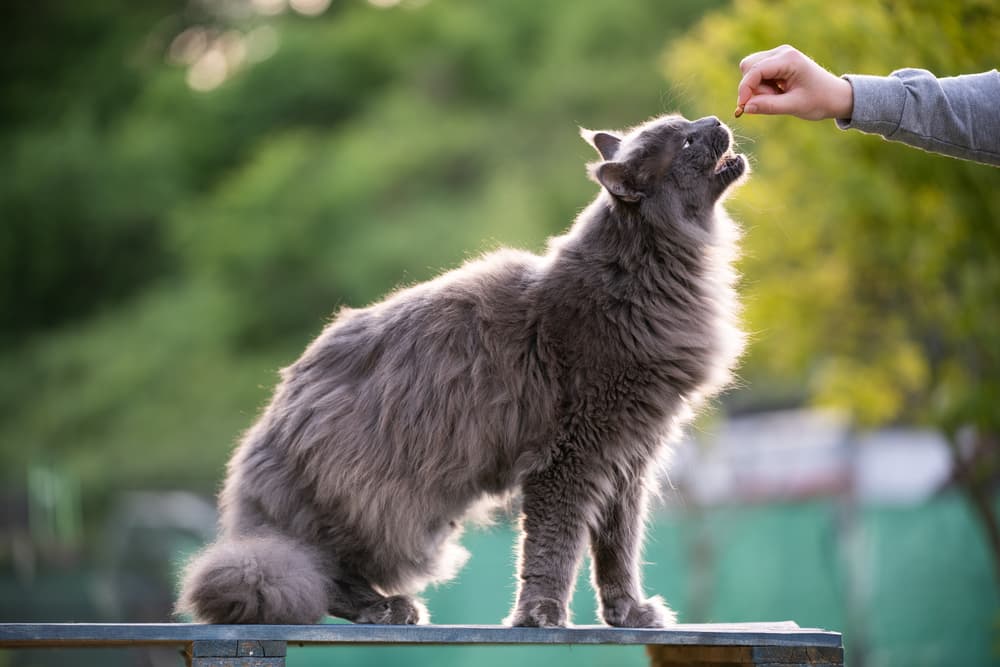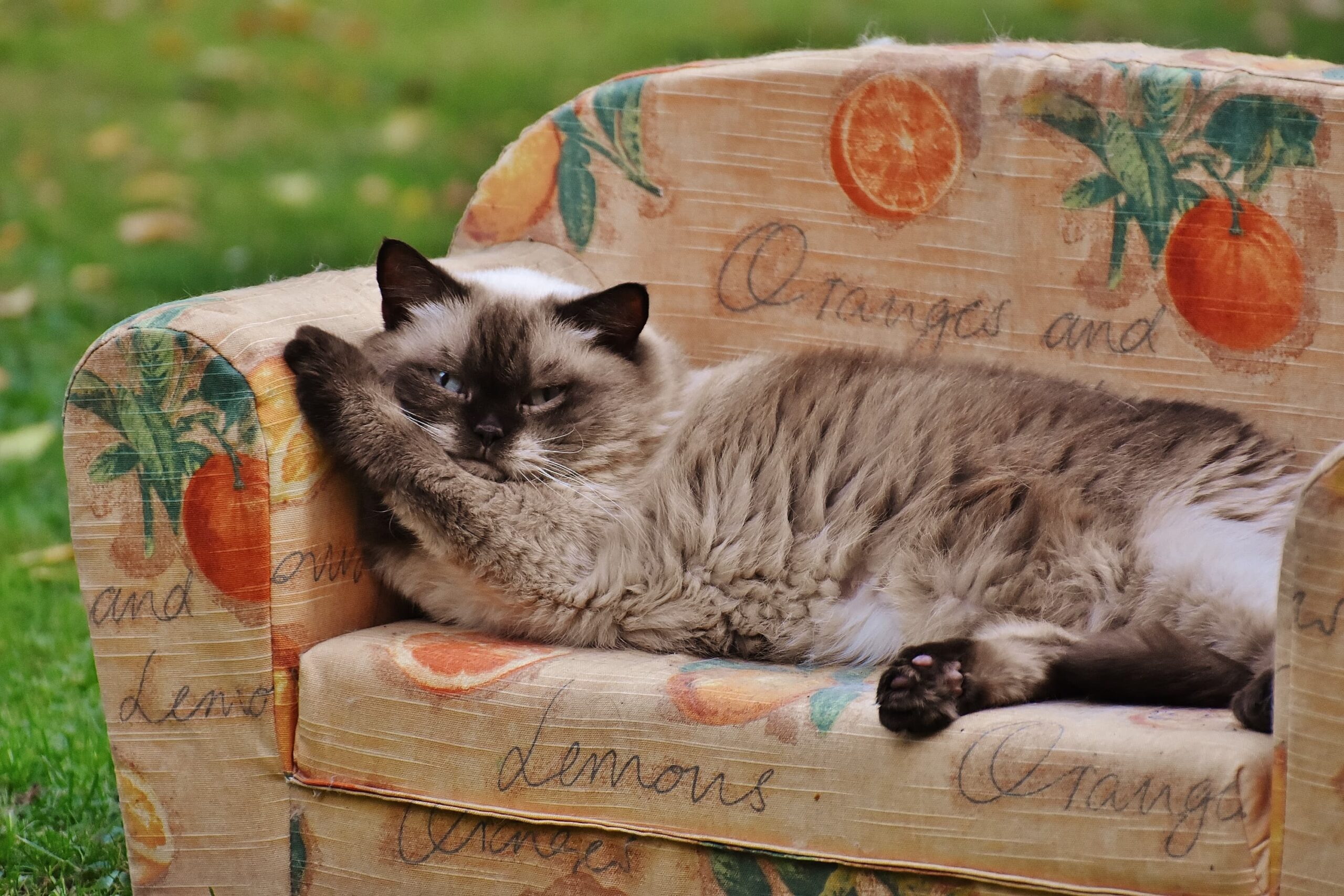8 Diabetic Cat Treats That Vets Love
Reviewed by Janelle Leeson. Updated on July 15, 2024
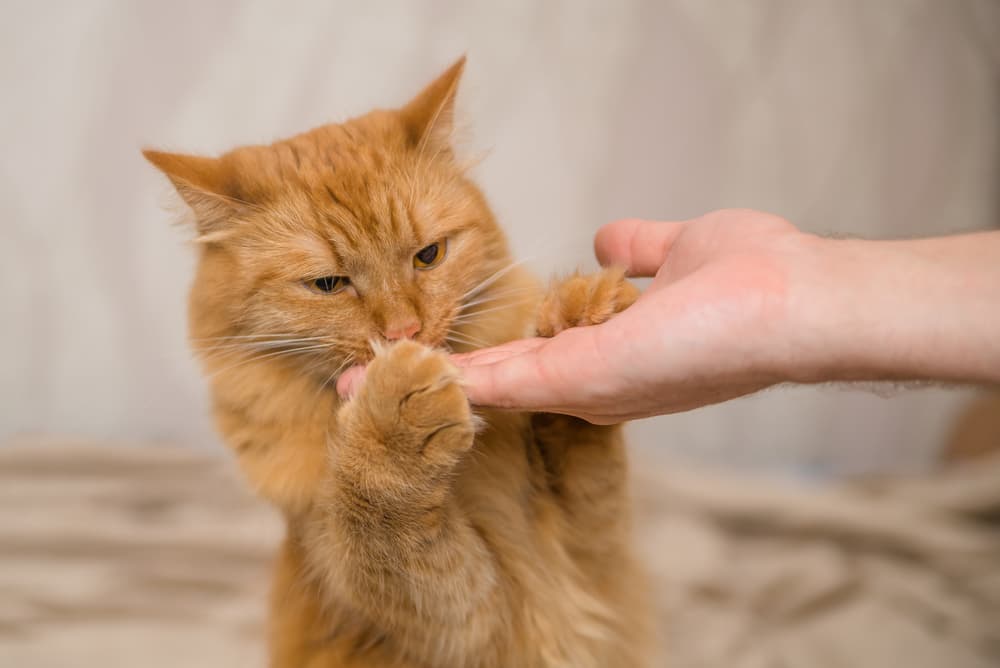
If your cat has been diagnosed with diabetes, your veterinarian has likely discussed some pretty big life changes, like a special diet and insulin to help manage their condition. But that doesn’t always mean your cat must give up their favorite things in life—such as cat treats.
“An important goal in the treatment of diabetes in cats is to maintain a good quality of life, and for the vast majority of cats, treats can still be a part of this,” Dr. Nyssa J. Reine-Salz, a small animal veterinarian and internal medicine consultant for Merck Animal Health.
The diagnosis of diabetes in cats is on the rise [1], which means there’s a growing need and market for cat treats made especially for your diabetic cat.
Top Diabetic Cat Treats
All featured products are chosen at the discretion of the Vetstreet editorial team and do not reflect a direct endorsement by the author. However, Vetstreet may make a small affiliate commission if you click through and make a purchase.
- Best Overall Diabetic Cat Treat : PureBites Freeze Dried Cat Treats
- Best Raw Treats for Diabetic Cats: Vital Essentials Freeze Dried Chicken Hearts
- Best Limited Ingredient Treats for Diabetic Cats: Whole Life Just One Ingredient Freeze-Dried Treats
- Best Lickable Cat Push Up Treats for Diabetic Cats: Inaba Churu Cat Treats
- Best Low Carb Canned Cat Food for Diabetic Cats to Use as a Treat: Purina Pro Plan Veterinary Diets DM Wet Cat Food
- Best Treat for Training a Diabetic Cat: Halo Freeze-Dried Raw Cat Treats
- Best Treat Toppers for Cats with Diabetes: Cat-Man-Doo Extra Large Bonito Flakes
- Best Tuna Cat Treats for Diabetic Cats: Vital Essentials Ahi Tuna Bites Freeze-Dried Raw Cat Treats
8 Best Veterinarian-Approved Diabetic Cat Treats
If you have a diabetic cat, there’s no need to forego treats. Everything in moderation, and always run any dietary or feeding questions by your veterinarian. We love that the majority of options on our list are nonprescription.
Best Overall Diabetic Cat Treat
Our pick: PureBites Freeze Dried Cat Treats

High in protein and low in carbohydrates is just what the veterinarian ordered and what PureBites serves up. The selection of healthy proteins ranges from chicken and turkey to lamb and beef liver. Whichever protein you choose, you can feel good knowing these treats are made from a single ingredient without fillers or sugars.
Highlights
- Made with one single ingredient: USA-raised protein
- Low in calories with no added fillers or sugars
- Available in a wide selection of flavors
- Can be easily broken for smaller serving sizes
Things to Consider
- Cats can have allergies to certain proteins, like chicken. Like any new food, introduce a small amount and monitor for any reactions before providing a full serving.
Best Raw Treats for Diabetic Cats
Our pick: Vital Essentials Freeze Dried Chicken Hearts
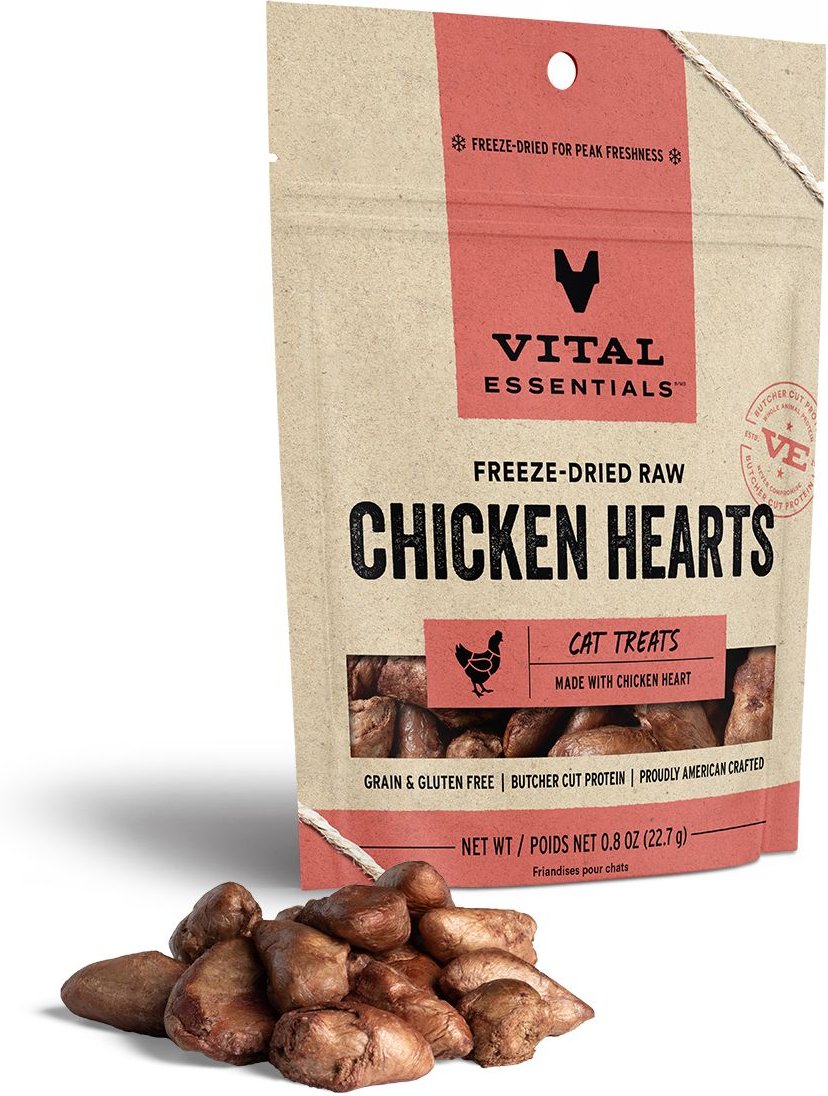
They might not look appetizing to you and me, but your wild-at-heart (pun intended) kitty will go crazy for the rich taste of these single-ingredient cat treats. Plus, they have all the benefits of raw protein, but are easier to store and use than traditional raw foods and treats. You can also crumble these up and add them to your cat’s food if your feline is a bit picky.
Highlights
- Made with one single ingredient: USA-raised protein
- Good source of taurine
- No grain, gluten, soy, or dairy
- No artificial colors or flavors
Things to Consider
- These treats are exactly what they say they are: freeze-dried chicken hearts. If that makes you queasy, you might want to consider one of Vital Essentials’ many other protein choices.
Best Limited Ingredient Treats for Diabetic Cats
Our pick: Whole Life Just One Ingredient Freeze-Dried Treats

These limited-ingredient treats from Whole Life Pet have all the makings of an ideal diabetic cat treat. They have one, single-source protein (turkey) and nothing else. That means, they don’t have carbohydrates or other ingredients that can mess with a cat’s blood sugar. We’re big fans of this specific freeze-dried treat because it’s made without chicken, so it’s a good option for cats who might have food intolerances or sensitivities to poultry. Plus, turkey is a nice salmon alternative!
Highlights
- High-protein treat with one single ingredient
- Doesn’t contain antibiotics
- Freeze-dried to preserve freshness
- Good alternative protein for cats with chicken sensitivities
- Made without chemicals or preservatives
- Made in the USA
Things to Consider
- The treats have a soft, meaty texture
- Product is gently steamed
Best Lickable Cat Push Up Treats for Diabetic Cats
Our pick: Inaba Churu Cat Treats
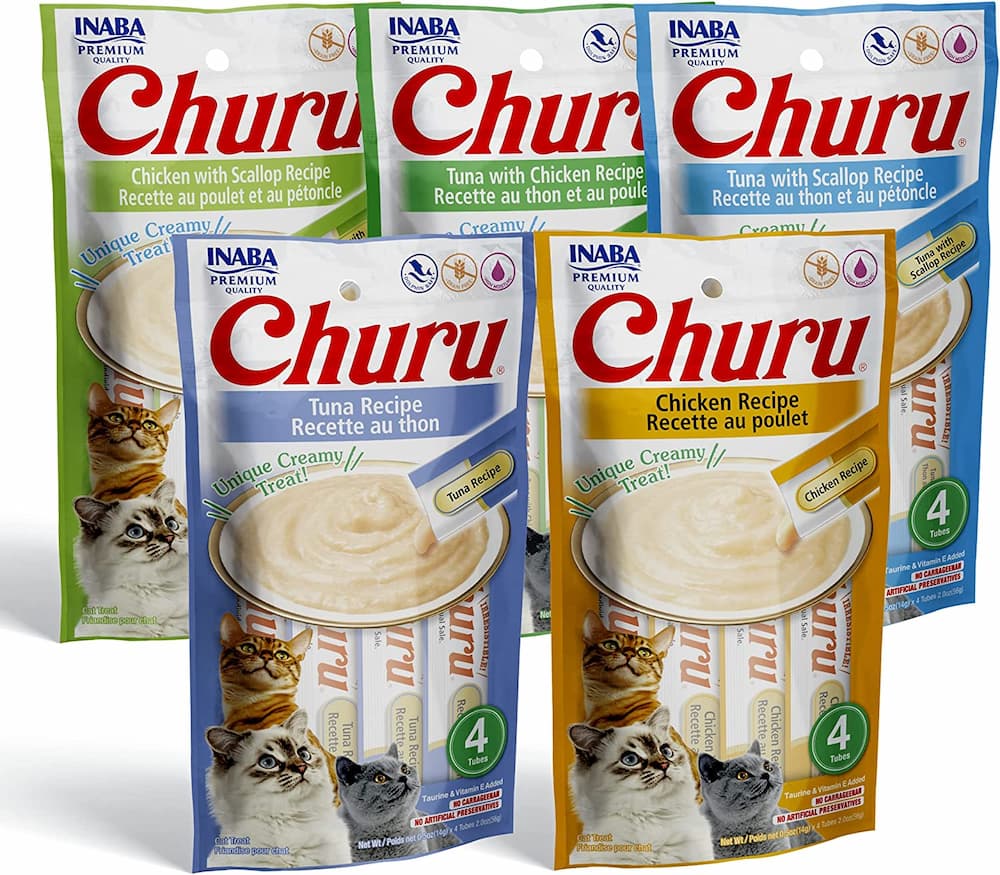
Churu puree treats are loved by just about every cat. A wet treat packaged in a skinny tube to hand-feed your favorite feline, the benefits of lickable cat treats go far beyond your cat’s taste buds. Lickable cat treats promote human-cat bonding [2], can be used to distract your cat during unpleasant activities (like getting an insulin shot), and have an easy-to-eat blended formula that cats of all ages can enjoy. Plus, “high-moisture foods contribute better to a feeling of satiety,” Dr. Myers says.
Highlights
- Suitable for senior cats
- The first two ingredients are water and protein
- Keeps your cat hydrated and feeling full
- Good choice for seniors
- Packet is easy to tear
- Come in a wide variety of cat-approved flavors
Things to Consider
- At six calories per tube, this treat should be given in moderation.
Best Low Carb Canned Cat Food for Diabetic Cats To Use As A Treat
Our pick: Purina Pro Plan Veterinary Diets DM Wet Cat Food

We love the idea of using this canned cat food from Purina as a treat for cats with diabetes. It requires a veterinary prescription so you know it contains high protein and low carbs for your kitty. As a bonus, the formula is ideal for creating an unfavorable environment for calcium oxalate and struvite stones to form. Cats with diabetes, enteritis, hyperglycemia, or those with loose stools may benefit from this cat food.
Highlights
- Made in the USA
- Ideal for all adult life stages of diabetic cats
- High protein and pea-free diet
- Can be used as a nutritious low-carb canned treat
- Can also be used as a prescription diet for diabetic cats
Things to Consider
- Requires a veterinary prescription
- Minced consistency
Best Treat for Training a Diabetic Cat
Our pick: Halo Freeze-Dried Raw Cat Treats
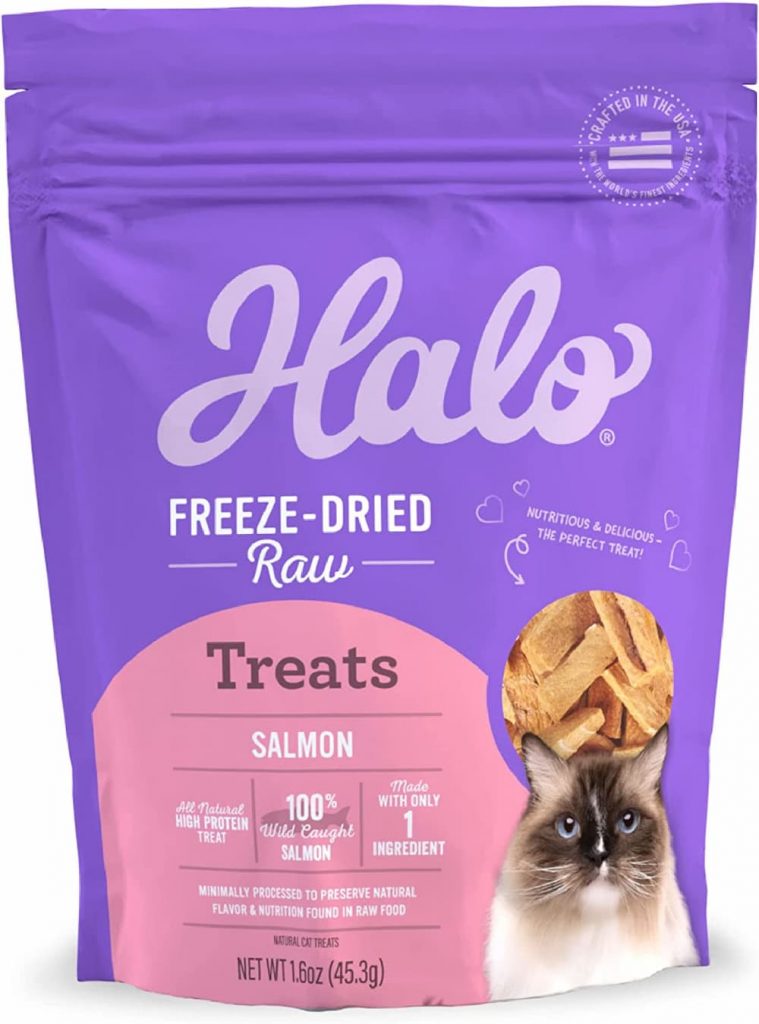
Training is a great way to get your diabetic cat some exercise and work on bonding. But finding low-calorie, no-carb training treats that are healthy for cats with diabetes can be challenging. But these single-ingredient, salmon-based treats are a nice option because the salmon chunks can be broken up for easy treating while training.
Highlights
- Only one ingredient: salmon
- Easy to break up treats for training
- Low calorie option for diabetic cats
- Made in the USA
Things to Consider
- The bag is small and these are on the pricey side for treats
- Treats can break a bit and turn powdery during shipping and handling
Best Treat Toppers for Cats with Diabetes:
Our pick: Cat-Man-Doo Extra Large Bonito Flakes
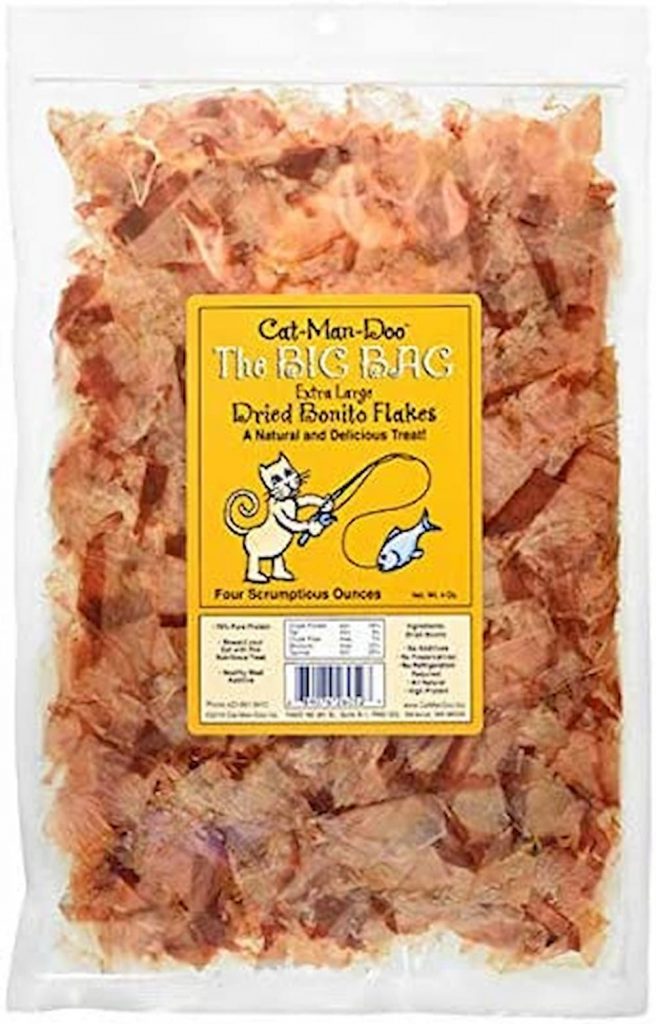
Is your cat turning her nose up at her prescription diabetic kibble? These double-duty treats do the trick as a healthy reward or a tasty meal topper that will lure your cat back to her bowl. Like other diabetic-friendly cat treats, Cat-Man-Doo Extra Large Bonito Flakes are made from a single high-protein ingredient. Plus, they’re packed with naturally occurring taurine and omega-3 fatty acids.
Highlights
- Made with one single ingredient: human-grade bonito flakes
- Low calorie with no added fillers or sugars
- A skin, joint, and heart-healthy treat
Things to Consider
- These really are better used as food toppers than individual treats
- Flakes can get crushed in shipping and handling, leading to powder and mess in the bag
Best Tuna Cat Treats for Diabetic Cats
Our pick: Vital Essentials Ahi Tuna Bites Freeze-Dried Raw Cat Treats

For cats who prefer the taste of tuna, consider Vital Essential’s Ahi Tuna Bites. These freeze-dried snacks contain one single protein and are free of grains, gluten, artificial colors and artificial flavors. Because they are grain-free, they are ideal for diabetic cats with allergies or sensitive stomachs. The guaranteed crude protein in each bag is 40%, and they are made in America.
Highlights
- Raw freeze-dried, single ingredient protein (tuna)
- Grain-free and gluten-free
- Meat-based recipe with no artificial ingredients
- Can be used as a meal topper
- May help clean teeth and gums as your cat chews
Things to Consider
- Not all cats may enjoy the flavor
- Double check with your veterinarian for any feeding concerns
- Formulated for adult cats only
Can I Give My Diabetic Cat Treats?
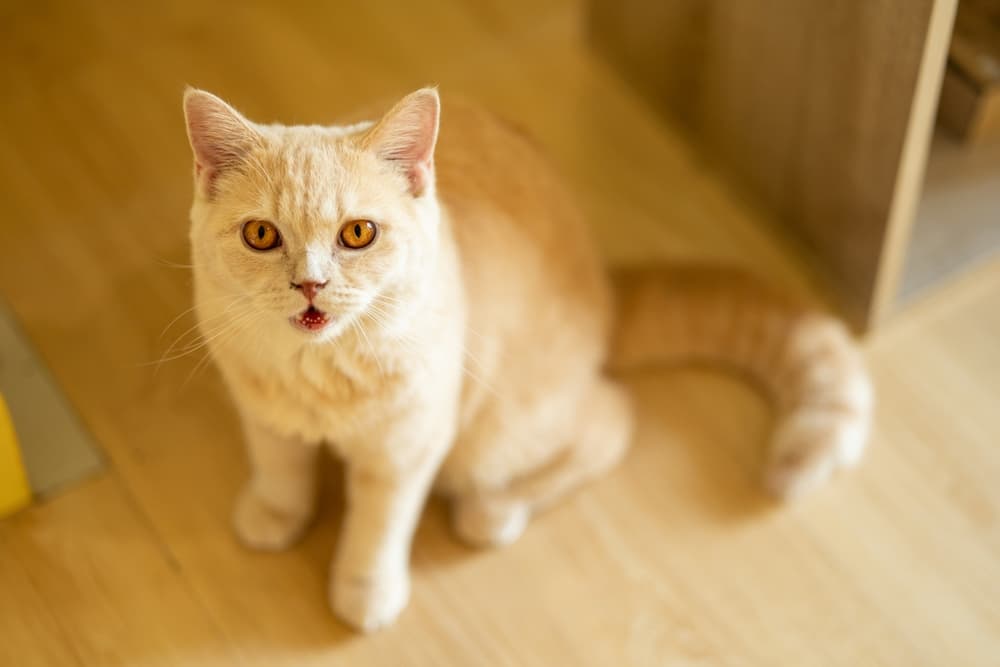
When your cat is first diagnosed with diabetes, your veterinarian will discuss what is called the regulation phase, or the period when your veterinarian is determining the best dose of insulin for your cat. “During the regulation phase, it is ideal to leave treats out [of the diet],” Dr. Reine-Salz says. “Once good regulation is established, and if your veterinarian believes it is appropriate, treats could be reintroduced.”
But there’s a caveat. Most cases of diabetes in cats resemble Type II diabetes. This means the cat can make insulin, but there’s something else going on that isn’t allowing insulin to work properly. Typically, this “something else” is obesity.
While certain types of treats or too many treats can lead to weight gain in cats, they’re not completely off the table (or permitted in the cat bowl). But Dr. Jo Myers, a veterinarian with Vetster encourages pet parents to explore calorie-free methods of showing their cat affection via play, brushing, or simply sitting next to their cat. “This applies to all cats, both with and without diabetes,” she says.
Dr. Myers has a few exceptions to her limited-treat rule, and that’s during training exercises with your cat and when using puzzles for mental stimulation. Still, she says, if you choose to feed your diabetic cat treats and your veterinarian approves, treats shouldn’t make up more than 5 percent of your cat’s daily calorie needs.
What to Look For in Diabetic Cat Treats
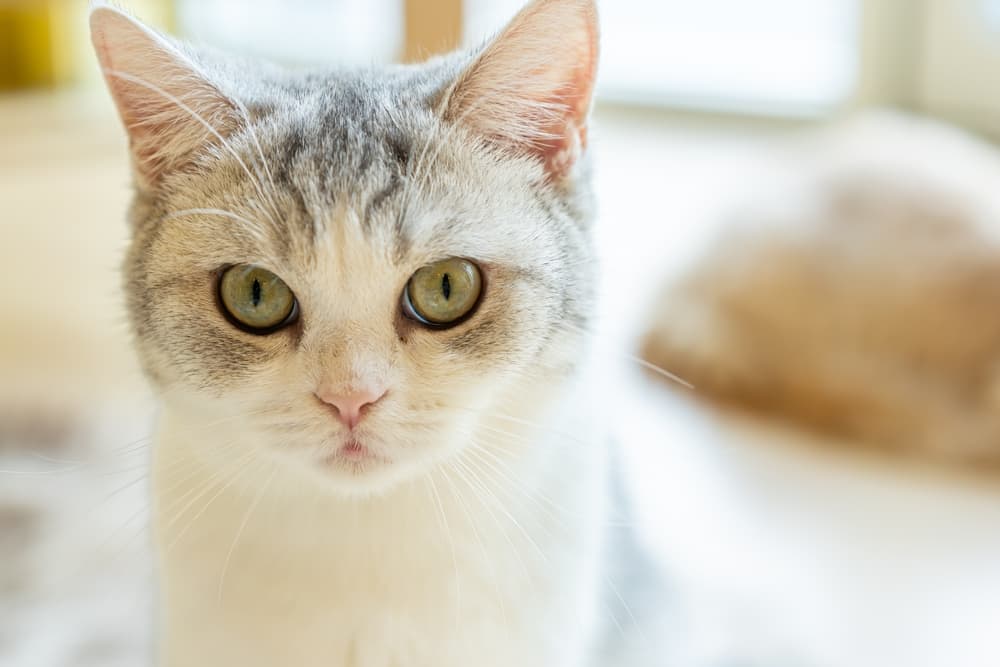
According to Dr. Reine-Salz and Dr. Myers, the diet of a diabetic cat looks a lot like the biologically appropriate diet of any cat: high in protein, moderate in fat, and low in carbohydrates. Once you and your veterinarian decide on the most appropriate selection of diabetic-friendly food and treats for your cat, it’s important to stick to that diet.
Ingredients aren’t the only consideration when choosing the right diet for your cat. Review the calorie density of treats and food and portion control based on your cat’s ideal weight, Dr. Myers says. “Nutritional therapy is critical for successful management of all types of Diabetes mellitus and can even lead to remission for Type II Diabetes mellitus.”
Diabetic Cat Treat Buying Guide
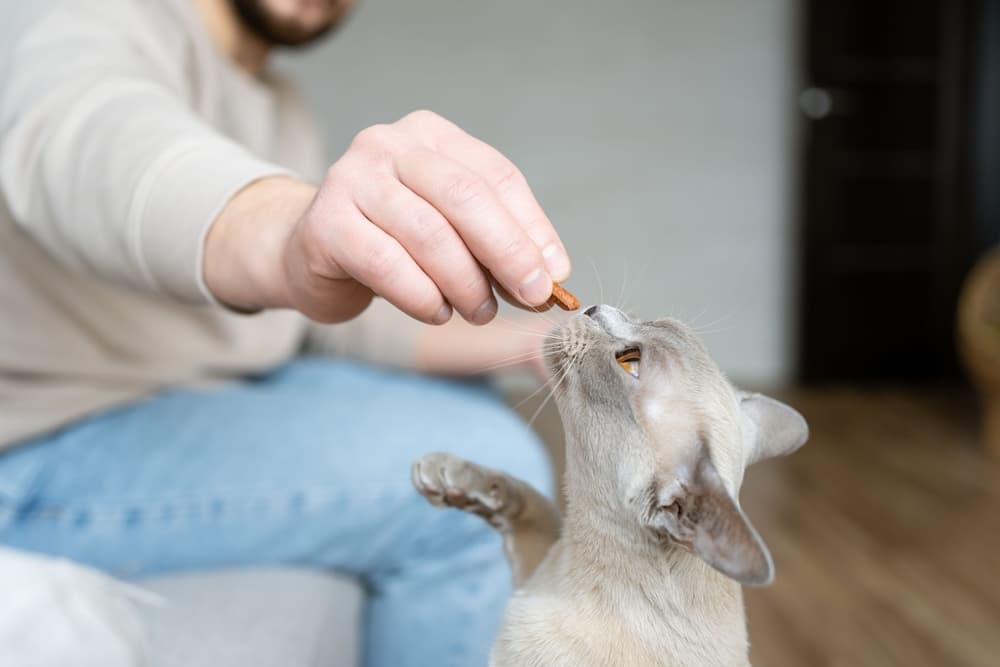
Here’s what you should keep in mind before purchasing treats for your diabetic cat:
Talk to your veterinarian. When purchasing treats for cats with diabetes, first, talk with your veterinarian. Your vet will know what’s best for your cat’s individual needs and can recommend treats that can keep your feline’s diabetes under control.
If your veterinarian doesn’t give the a-okay for treats in addition to a complete and balanced prescription meal, Dr. Myers says puzzle toys and foraging games aren’t out of the question. “Puzzle toys can be filled with small amounts of a cat’s prescription food as a treat,” she suggests.
Timing of treats. When it comes to diabetes, timing of feeding and insulin administration is critical to successfully manage blood sugar. To give your cat the best chance of having controlled blood sugar, ask your vet for the best times of day to give your cat treats or use food puzzles.
Do you need a prescription? Needing a prescription for diabetic cat treats shouldn’t be a deal-breaker. In fact, you can feel good knowing your cat’s treats have been specially formulated for your cat’s unique needs. However, prescription diets and treats can cost more than over-the-counter diabetic-friendly options. So, talk to your veterinarian about any concerns and budget-friendly alternatives.
Just as there are options of non-prescription food for diabetic cats, there are many non-prescription diabetic cat treats, as you can see from our list above.
Read the ingredients. Cats are obligate carnivores that thrive on a meat-based diet [3]. That means when shopping for your cat’s treats, look for high-quality, protein-forward treats and pass on low-quality treats packed with carbohydrates. This is especially true for diabetic cats and cats on a weight-management diet.
Count calories. Dr. Reine-Salz heeds an important warning: “Some cat treats can be as much as 40 calories per treat!” According to Dr. Myers, treats should make up a maximum of 5 percent of your cat’s daily calories. Too many treats and cats are at risk of gaining weight or sacrificing calories from their complete and balanced meals – both of which can interfere with the management or remission of diabetes.
Consider texture. Cats have lots of opinions, and they might prefer one texture of a treat over another—like chewy, crunchy, or freeze-dried. Senior cats might find soft or liquid treats easier to enjoy. “If an individual cat enjoys the liquid push-up treats, in many cases that nutrient profile will be more consistent with a diabetic cat nutrient profile than more carbohydrate-heavy crunchy treats,” Dr. Reine-Salz adds.
FAQs About Diabetic Cat Treats
Now that you know more about treats to feed a diabetic cat (in moderation), you will want to look for a canned high-protein, low-carbohydrate diet. A non-prescription food for diabetic cats that is low carb should provide less than 10 percent of the total calories as carbohydrates.
As a diligent pet parent, you will manage your cat’s diabetes with a combination of your veterinarian’s direction, diet, insulin injections, and blood glucose monitoring.
It may seem overwhelming to share life with a diabetic cat, but it’s all about having a plan in place. A treatment plan for diabetic cats can start you off on the right foot and help successfully manage their condition.
In addition to helping keep cats hydrated due to their high moisture content, Churus are very palatable so most cats love them. If you have a picky diabetic cat, Churus are tasty and low in calories, making them a win-win.
Churus are formulated for cats. You can talk to your veterinarian if your dog wants to eat them, too. Your dog may experience gastric upset because cat treats generally have more fat content than dog treats.
If you have specific questions about dry food for your diabetic cat, it is best to ask your veterinarian.
Resources Cited
1 https://www.avma.org/javma-news/2021-09-01/helping-diabetic-pets-live-happily-ever-after
2 http://www.animalbehavior.net/LIBRARY/Feline/PCP_Library/PCP_HandFeeding.htm

